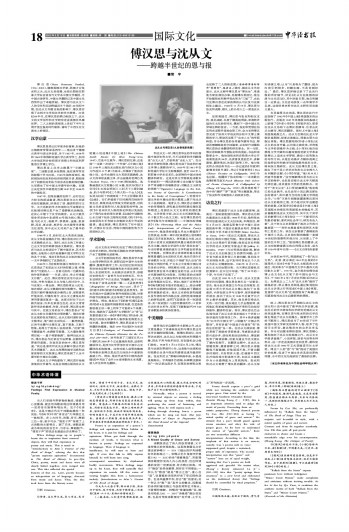情发于声/qínɡfāyúshēnɡ/Feelings Find Expression in Musical Poetry.
当人们受到外界事物的触发,情感在心里激荡,就会用诗歌表现这种情感并用一定的音乐旋律咏唱出来。见于《毛诗序》。这是中国古代关于诗歌起源的一种说法,与《尚书》中的“诗言志”大体接近且一脉相承。在上古时代,诗歌、音乐、舞蹈三位一体,密不可分,“情发于声”体现了上古诗歌的主要特点。到了后来,诗歌逐渐成为单纯的语言艺术,与音乐、舞蹈脱节,“情发于声”的说法也就退出历史舞台了。
Whenfeelings surge up in people’s hearts due to inspiration from externalobjects, they will find expression inpoetry and music. This is stated in“Introductions to Mao’s Version ofThe Book ofSongs,”echoing the idea that“poetry expresses aspirations”documented in The Book of History.In pre-Qin China, poetry, music and dance were all closely linked together, even merged into one. This idea reflected the specialfeatures of that era. Later, poetry became an independent art of language, divorced from music and dance. Thus, the idea took leave from the literary scene.
引例 Citations:
◎诗者,志之所之也,在心为志,发言
为诗。情动于中而形于言,言之不足,故嗟叹之,嗟叹之不足,故永歌之,永歌之不足,不知手之舞之足之蹈之也。情发于声,声成文谓之音。(《毛诗序》)
(诗是内心情感意志的表达,藏在心里就是情感意志,用语言把它表达出来就是诗歌。情感在心中激荡而用语言表达出来,用语言还表达不尽,便加上嗟叹的声音,嗟叹还不尽情,就放开喉咙吟唱出来,吟唱仍感不足,于是不知不觉手舞足蹈起来。感情在心里激荡,就会表现为声音,声音按五音的高低组成旋律就成了音乐。)
Poetry is an expression of a person’s feelings and aspirations. When hidden in his heart, it is just his feelings andaspirations. When put forth through the medium of words, it becomes what is known as poetry. Feelings are expressed in language. Then if language isinsufficient, he will start to hum and sigh. If even that fails to fully express himself, he will burst into song,accompanied sometimes by rhythmical bodily movements. When feelings surge up in his heart, they will naturally find expression via sounds. All five notes of varying heights thus form a harmonious melody. (Introductions to Mao’s Version ofThe BookofSongs)
◎大凡人之感于事,则必动于情,然后兴于嗟叹,发于吟咏,而形于歌诗矣。(白居易《策林·六十九·采诗以补察时政》)
(一般来说,人们受外界事物感动,就必然激发内心的情感,随之而发出嗟叹的声音,并用音乐将这种感情吟唱出来,于是就产生了可以歌唱的诗。)
Normally, when a person is moved by external objects or scenery,a feeling will spring up from deep within, thus producing the sound of humming and sighing.Then he will express such afeeling through chanting; hence a poem which can be sung out loud. (Bai Juyi:Collection of Essays in Preparation for the FinalRoundofthe ImperialExamination)
情兼雅怨/qínɡ jiān yǎyuàn/A Mixed Quality of Grace and Sorrow
诗歌既表达了诗人的怨苦情感,又不违背雅正的审美标准。这是南朝著名文学理论家钟嵘(? —518?)提出的评判诗歌好坏的标准之一。钟嵘从艺术角度评价曹植(192—232)的诗“情兼雅怨”,其意强调诗歌要抒发诗人内心的怨苦,但这种情感的宣泄一定要适度,符合雅正标准。对于“雅怨”的具体解释,则存在不同看法:一种认为“雅怨”就是“雅正之怨”,重心在“怨”,说曹植的诗虽然抒发了受压抑的怨苦,但诗风温厚平和,符合“雅”的要求;另一种认为“雅”“怨”是并立的概念,说曹植的诗同时兼有雅正与怨苦两种艺术特点。不管哪种理解,钟嵘的“情兼怨雅”说,既是对陆机(261—303)“诗缘情”理论的发展,也是对传统诗歌理论“发乎情,止乎礼义”所作的进一步说明。
Poetryshould express a poet’s grief while not violating the aesthetic rule of proper grace. First raised by therenowned Southern Dynasties literarytheorist Zhong Rong (? – 518?), this is an important criterion used to judge the merit of poetry. Proceeding from anartistic perspective, Zhong deemed poems by Cao Zhi (192-232) as having“a mixed quality of grace and sorrow.”He stressed that a poet should guard against excess emotion and obey the rule of proper grace. As for how to understand the notion of“graceful sorrow,”there are two somewhat differentinterpretations. According to the first, the emphasis of that notion is on sorrow;namely, Cao’s poems seek to voicesuppressed grief, despite a restrained,proper style of expression. The secondinterpretation says that“grace”and“sorrow”here are of equal weight,insisting that Cao’s poems are bothaggrieved and graceful.No matter what,Zhong’s theory enhanced Lu Ji’s(261-303) idea that“poetry springs from emotions”to a new level and elaborated on the traditional theory that“feelings should be controlled by ritual propriety.”
引例 Citations:◎魏陈思王植,其源出于国风,骨气奇高,词彩华茂,情兼雅怨,体被文质,粲溢今古,卓尔不群。(钟嵘《诗品》卷上)
(魏陈思王曹植的诗可以溯源于《诗经》中的国风,格调气度极高,文采华丽繁茂,情感兼具雅正与怨苦,文采与内容统一,光辉灿烂超越古今,卓然独立而不与众人为伍。)
Poems by Cao Zhi, are profoundly influenced by“Ballads from the States”ofThe BookofSongs.They aremajestic and beautiful in style, with a mixed quality of grace and sorrow.Content and form fit together seamlessly.Cao Zhi thus puts all past poeticendeavors to shame and boasts aremarkable edge over his contemporaries.(Zhong Rong: The Critique ofPoetry)
◎《国风》好色而不淫,《小雅》怨诽而不乱,若《离骚》者,可谓兼之矣。(《史记·屈原贾生列传》)
(《国风》虽然描写爱恋情欲,但是并不放纵;《小雅》虽有怨恨与批评,但并不煽动作乱。至于屈原的《离骚》,可以说兼有《国风》和《小雅》的美。)
“Ballads from the States”expresspassionate love without indulgence.“Minor Court Hymns”make complaints and criticisms without inciting trouble. As for LiSao by Qu Yuan, it combines the aesthetic merits of both“Ballads from the States”and“Minor Court Hymns.”(Records ofthe Historian)



 上一版
上一版


 缩小
缩小 全文复制
全文复制 上一篇
上一篇